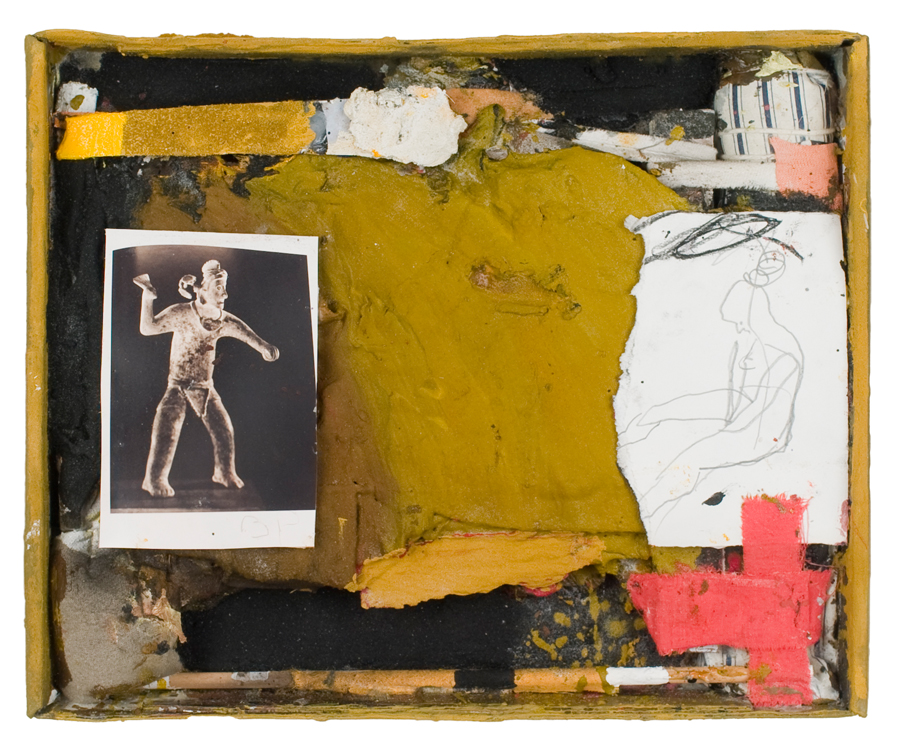
James Havard Stays Ahead of the Beast, Just Barely
James Havard is a painter whose new show at Zane Bennett Contemporary boasts an extensive archive of his work. From monumental paintings to works in period picture frames and in shadow boxes, the show continues down little hallways and around gallery corners manifesting paint globs, mixed media and intense cultural references. Staying Ahead of the Beast, often dirty feeling, even cage-like, reads out apprehensive identities. Bits of fabric, newspaper clippings, wads of mummified string, talismanic objects and gestural childlike forms weave out a narrative that conveys neither an aesthetic nor social utopia.

In B.P., a twelve-by-fifteen shadow box, an image from an art history book rests on the left-hand side. It’s a Neolithic figure of a man about to throw a primitive weapon. The whole figure appears to be carved from stone and he wears a loin cloth, ritualistic jewelry and possibly an animalistic headdress. Facing into the box, he’s about to hurdle his weapon across the great divide of matted yellow ochre to his inmate who sits nearly resigned on the other side of the box. Presumably sketched by the artist, this figure has its head down with a scribbled oval above his head, as if a halo forced its way out of Havard’s commanding hand onto the portrait, transforming him into a fallen angel. If this is Havard’s image of today’s cultural icon, what are we to learn from B.P.? Both images are leveled side by side, but which one is the more dominant, today’s fallen angel or yesterday’s warrior?
Partly funny and partly serious, Staying Ahead of the Beast (which reveals work from the 1980s and 1990s as well as more recent) is spawned from some mammalian instinct that’s profoundly enamored with our psychological ancestral history—and beware because it’s kind of ugly or maybe just really murky. Deformed spiritual mascots set in ruinous landscapes composed of color, line, scribbled disasters and acrylic lumps feel like the tactile hefty curvature of the Venus of Willendorf. Although perfectly relevant today–in that Havard is working now (he will be celebrating his 75th birthday on June 29th) and still very engaged in his artistic practice–Havard somehow turns his paintings into self-conscious relics.
His shadow boxes feel like maybe they should still be buried. They line the upstairs atrium with categorical authority and although never buried to my knowledge, they definitely look like time capsules that are full of barely organized stuff. Taken as such, it seems that somebody wanted to say something about us. We did not stumble upon these objects during an archological dig but in 2012 at Zane Bennett.
Photographs look like art history book tear sheets that show ladies period fashion and Neolithic wooden creatures. In Porque Fue Sensible, the tension is set between a plaster effigy and an image of a refined dilatante. Paper piles between them with a big squirt of opalescent paint that says “2.” His personal contributions combine with found objects that look quite compliant in their anachronistic nests. By preserving these disparate elements under glass, entrenching them with paper scraps and textile clumps, used dried paintbrushes and matted pigment, Havard makes the interiors look distanced and removed even if the paint just finished drying.

Whether or not we are in fact “staying ahead of the beast,” Havard makes the line of pursuit a very close call.

